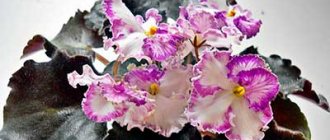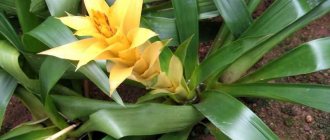There are many varieties of Saintpaulias, and their number increases every year. African Night, one of the largest and darkest varieties.
There are reasons why it is not to everyone's taste, but its color does not leave anyone indifferent. Photos and descriptions of the variety can be studied in more detail in the article.
And when planning to get yourself a new pet, it is important to know:
- What will the flower be like?
- And how to properly care for it.
Otherwise you can :
- Or be disappointed;
- Or destroy the plant.
Violet African Night (K. Katkin)
In terms of size, the African can be classified as standard, and some individuals can even be classified as large varieties . Saintpaulia leaves:
- Large;
- Dark green with a reddish underside;
- Prone to impaired horizontal growth;
- And they reach to the top.
The flowers are large, deep dark purple, and abundant light can result in blue blooms .
African night original.
This variety was bred in Odessa by breeder K. Katkin . For a long time, it was considered the darkest variety, and this was the reason for its popularity. But the simplicity of the flower and the dimensions of the rosette, after the appearance of darker options, pushed this beauty to the lower positions.
After reproduction, sport flowering is quite often observed . The color usually remains the mother's, only the underside of the petals is slightly lighter.
African night sports.
Attention! Most of these offspring have slightly double flowers, which, as before, are huge in size, but more of them are formed on the peduncle (standard 1-2, sport 3-4).
We'll talk about care and reproduction below.
Violet Pink watercolor, panther, marshmallow and other varieties
Saintpaulia of this delicate color was not created just like that. From time immemorial, pink has symbolized harmony between passion and innocence; it is the color of contradiction in love, feelings and femininity.
That is why flowers of this shade have always been highly valued. Pink watercolor is a uniquely beautiful variety, with very large flowers (double) of pale pink color. The center is blurry, white, the edges look like a lacy white border. This is variety K.
Moreva. It is called graceful variegated leaf.
Each leaf is bordered by a white stripe along the edge, although it itself is dark. This makes the plant even more delicate and original. The airy waviness of the petals appeals to many collectors.
The name is associated with the peculiarity of the color: pink strokes are visible on the white flowers, as if painted with an artist’s brush. Sometimes this Saintpaulia is almost completely white, sometimes, on the contrary, it is very bright.
It blooms for a very long time, and in excellent light it will produce large flowers more than six centimeters in diameter. Their value is also affected by the ambient temperature. Pink watercolor likes cool, and the brightness increases as the difference between the air temperature at night and day increases.
Removing leaves is not recommended: this procedure can delay the onset of flowering for a long time or make it less lush, abundant and beautiful. If you strictly adhere to all the rules of caring for the plant, then this Saintpaulia will be a lush, graceful and elegant beauty in the owner’s collection.
Pink Panther
Saintpaulia variety Pink Panther belongs to the selection of K. Morev. Panther has large flowers, light pink in color, with a large white edge. The leaves are not dark, but not light either, scalloped, slightly pointed.
Some features of caring for violets of the Panther variety:
- If the rosette is exposed to excessive light, the color may become more pink, “floating” onto the white border and making the color generally more washed out;
- Also, a common problem when growing the Panther variety is too many leaves - this is often also related to lighting;
- During the first flowering, there are often no iridescent shades observed - the petals are completely pink;
- Leaves become denser when exposed to excess light;
- The wait for flowers may be delayed - the Panther is not a fast subspecies in this regard.
Often, collectors grow two varieties together: Saintpaulia Blue Mist and Panther. They are similar in foliage shape, look good next to each other, and the rules for caring for them are very similar. They cannot be overheated or overexposed, but otherwise the Panther is not at all capricious, according to reviews from amateurs.
The Pink Panther sometimes blooms with small flowers. But this does not mean that the next flowering will be the same. Under good conditions, the Panther will manifest itself in all its glory, with all the beautiful tints of color on large petals characteristic of this variety of violets.
Pink marshmallow
Violets of this variety are distinguished by variegated rosettes, lush flowers, double appearance, and very bright (light crimson) color of the petals. The species was bred by Lebetskaya. It is quite rare, but very beautiful.
Terry stars look like a plentiful, lush cap above the leaves. The leaves are even, variegated - with a delicate white border along the edge of the dark green leaf.
One flower reaches 5-6 centimeters, the whole plant looks compact.
Zephyr has very strong peduncles that stand upright. The flowers are light when they first bloom and darken over time. The maximum diameter is six and a half centimeters. Saintpaulia of this variety looks classic, without play or multicolor, and the variegation of the leaves adds elegance to it.
Young foliage can be very light. In general, Zephyr can be quite different under different conditions. Brightness is primarily affected by lighting, which is why Marshmallow often turns out pale and tender.
These flowers look more like small roses than violets. Zephyr blooms a lot of foliage, but it does not interfere with the growth of flowers, but, on the contrary, emphasizes the colors. In the first flowering, doubleness may not appear.
Saturation is added as one blooms - from beginning to end.
Pink Dalmatian
Saintpaulia variety Pink Dalmatian was bred by breeder Korshunova.
This incredibly interesting color – lilac-pinkish flowers with a contrasting fantasy pattern in the form of purple or lilac-raspberry spots on double petals – gained popularity among collectors very quickly.
The foliage of the Dalmatian is rich, the leaves are simple, even and neat. The dark color is emphasized by the brightness of the flowers. Sports of this subspecies sometimes turn out to be contrasting, white and purple, but also very beautiful.
The fantasy of a drawing can be difficult to convey to children. But with proper transplants and seating arrangements, no problems arise. Elegant flowers decorate the collection, distinguished by intricate petal patterns.
Fantasy flowers are not only dark lilac, but even eggplant. The only thing this variety lacks is variegation.
Otherwise, this Saintpaulia is very good both in care and in appearance.
Saintpaulia in different shades of pink is an original flower that stands out brightly among many others. This is probably why every violet lover’s collection includes at least one of the above subspecies.
Conditions for cultivation
In terms of care, the African Night variety is no different from others:
- Temperature. Violet is afraid of cold; the lowest and highest temperatures are 16 and 24°C, respectively:
- In winter, during the dormant period, it is necessary to reduce the heat to 16-18°C, this will give the bush a good rest and will delight you with flowering in the spring;
- In summer, you should not overheat the flower; the temperature should not exceed 24°, and 22° is optimal.
- Between seasons, temperature changes should be carried out gradually, without sudden changes;
Important! If the temperature changes sharply, the plant may get sick and even die. When the heat drops, rot forms, and a sharp jump leads to withering and drying of the leaves and core.
- The soil. All violets need light soil mixtures. You can purchase specialized soil in the store, or mix the ingredients yourself; the proportions depend entirely on the type of watering. The mixture consists of:
- 3 parts peat;
3 parts soil;
- 2 parts perlite;
- And 2 parts of sphagnum moss.
But flower growers often change it depending on their conditions and preferences . For wick irrigation, it is ideal to mix only peat and perlite in equal parts.
Soil for violets can be purchased at a specialty store.
Saintpaulias, including the African Night variety, are not cultivated in open ground. There are several reasons for this:
- Intolerance to direct sun;
- The need for specialized soils;
- The need for root watering, and death from water getting into the center of the outlet;
- They do not tolerate frost.
A young plant usually blooms a year after planting . It may produce peduncles earlier or later if conditions allow it or, conversely, if conditions do not allow it. You need at least 10 hours of daylight and a temperature above 18-20°.
African violet at home: how to replant Saintpaulia
It is best to replant into new, fresh soil every 6-8 months, or at the very least once a year.
Since violets are grown in soil that is quite poor in nutrition, the substrate is depleted during this period. In addition, during this time the substrate accumulates a large amount of salts from the water. For drip irrigation of violets, the cord also reduces its resource.
An important sign of the need for replanting is the appearance of a salt coating on the violet pot.
When transplanting an adult plant, they try to replace the soil completely. The soil should be slightly damp, this will allow you to remove the violet from the pot as carefully as possible. The soil is carefully removed, if necessary, old rotten roots are also removed, as well as the lower wilted leaves. Next, fill the pot with drainage and soil, place the plant in the pot and add soil so that the bases of the bottom row of leaves almost touch the ground, but the rosette itself is not buried in the ground.
Young plants are often replanted with partial replacement of the soil. The roots are lightly shaken off the old substrate and the violet is planted in a new pot and fresh soil using the same method described above (without deepening the rosette). This way the roots of the flower are less damaged.
Growing methods
grow a new bush using standard propagation methods:
- Seeds – after dusting, you can get a seed pod and try to raise the kids. This method is labor-intensive and does not guarantee effect; the seeds quickly lose their similarity, which is quite poor even in freshly collected material. To obtain offspring you must:
- Prepare a container: a flat container that can be tightly covered with film or glass is ideal;
- Pour soil, layer thickness 2-3 cm, moisten with a sprayer;
- Sow the seeds, you can sprinkle them with a very thin layer of substrate, but this is not necessary, cover them with glass or film, creating a greenhouse;
- After sprouting, you can open the container, the flowers dive after they become crowded, earlier it is possible, but this is not justified.
- Leaf and peduncle – take a leaf or peduncle from an adult plant and root it:
- The leaf is chosen from the second or third row, it must be healthy and strong; The peduncle needs to be thick, fresh and strong;
- Root in a convenient way: in water, in soil, with wick watering in moss;
- When the baby appears, it is grown on a leaf (peduncle), and then planted.
Most often, Saintpaulias are propagated by leaves. - Stepson – small babies often form in the axils of the leaves; they are planted in two ways:
- They wait for roots to form (this happens after the plant is deepened, to the level of the lower part of the stepson), then they are separated from the mother plant and planted in a small pot;
- Separate 4-6 leaves at the stage and root them like a leaf.
Attention! All resulting children, regardless of the method of reproduction, are transplanted into larger flowerpots as they grow. Care is no different from adults.
Shelves for violets
Marshmallow
“Where did the passion for violets begin? When did the first flower appear at home? — I asked Galina. And I heard an interesting story - how an ordinary gift turned into more than just a flower hobby. He became a part of Galina’s soul and life.
In 2000, a relative Irina gave Galina a violet for her birthday. This violet became the first drop in the ocean of Galina Leontyeva’s violet passion.
New items brought from the exhibition Grown-up Antares and Whipped Cream
“I started visiting flower exhibitions and sales, where you can buy rare violets,” says Galina, “and always returned home with a cutting—a leaf of a new variety, or a sprout of a violet, or a new adult violet.”
Violet became for Galina a new song of the soul, a new step into tomorrow. But it also required a lot of care. The first question became: where to place the pots of violets? How to provide all plants with light? It’s good when there are three violets on the windowsill, they have enough space and light from the window. What if there are 300 varieties of violets? Yes, each variety has children growing up, then how? This is where the regiments came to Galina’s aid.
Yes, ordinary shelves, but for the violets they turned into a multi-story home. From standard furniture shelves you can assemble racks of various modules, which can be conveniently placed next to the window sill, above the chest of drawers, and along the wall of the room. And definitely with lighting! Fluorescent lamps will enable plants to successfully develop and grow. And, of course, delight your mistress with the first flowering, responding with blossoming living beauty to your care for them.
For me, violets always evoke positive emotions, lift my spirits and make me feel like spring is approaching. And Galina admits: “Violet for me is a hormone of JOY!” So let there be more such joys in our lives!
Other articles about fresh flowers and those who put their love into them: Summer in the park. Lawn Magnolias. Summer in the park. Garden of Roses. Report from spring. Country Tulip. “My pride is Tulips!”. Violet fairy tale.
8 votes Average rating: 4.9 out of 5
Rules of care
Like all Saintpaulias, African Night requires special care . Violet loves moisture, the air should be sufficiently saturated with water, ideally 60-70%.
Water strictly at the root. If water gets on the leaves, it can cause burns, and at the growing point it can cause rot and death of the individual. The frequency of watering depends on the season:
- In winter, once every 2-3 weeks;
- In the summer every week or even more often.
Advice! Many gardeners transfer their violets to wick watering. This method simplifies the maintenance process and guarantees stable, moderate humidity.
to feed Saintpaulias with liquid products , specialized or for flowering indoor plants. The frequency of fertilizing, as well as watering, depends on the season. It is ideal to focus on the frequency of watering. In summer, every second and in winter, every third watering is carried out with the addition of fertilizer.
Pruning is usually carried out in spring and autumn . This procedure is not necessary, but it prevents the growth of excess foliage and gives the flower more strength to bloom. It is also important to trim faded flower stalks in a timely manner.
Violets have many different diseases.
African night is a fairly disease-resistant variety, but like all violets it cannot be completely invulnerable. Among the dangerous diseases it is worth highlighting :
- Rot. From excess moisture and too low temperatures, the flower can rot. There are different types, some of them can be contagious, but all of them do not develop with proper care;
- Burns. One of the dangerous injuries. A severely burned individual may die without proper resuscitation. To avoid such consequences, you need to place the violet in a bright place without direct sunlight (burns can appear from reflection from the snow, so in winter it is worth protecting the plants from abundant light from the window);
- Parasites. When one violet is attacked, everyone becomes a target. There is no prevention against pests, but stopping them is usually not difficult, the main thing is to identify them in time.
If poorly cared for, violets may become pest-prone.
Pink violet watercolor photo and description of the variety
Violets, or Saintpaulias, are one of the most unpretentious houseplants after cacti. Thanks to the long-term work of breeders, based on the standard variety with blue flowers, many different species with interesting colors were obtained, one of which is Pink Watercolor. This variety will be discussed in today’s material.
Characteristics and description of the plant
The author of the Pink Watercolor variety is Konstantin Morev. This man has been breeding violets since 1994 and has already developed many different varieties that are distinguished by their unusual appearance and quality, sometimes even exceeding modern American varietal specimens. Much attention in his works is paid to clearly defined brush strokes in the shades of violet petals.
The bushes of these flowers are small, up to 15 cm in height. The leaves are dense, green in color, on thick petioles. The veins are clearly visible on the inside of the leaf plates. The outer side of the leaf is darker in color and covered with a layer of soft transparent hairs.
The variety got its name due to the unusual coloring of the white petals, on which strokes are clearly visible, as if specially left with a brush with watercolor paint. The flowers are large, up to 6 cm in diameter. The core and border are white only if the temperature is maintained within +20°C, but when raised to +25°C and above, the flowers become completely pink.
Flowering is long-lasting and, when optimal conditions are created, is 10 months a year with a break of 1–2 months. It begins to bloom for the first time in June and ends in September-October, the second time flowering begins in winter, in December, and ends in March-April. The second flowering may not occur if the room temperature is too low.
Conditions for growing violets at home
For full development, Saintpaulias need certain conditions that will be as close to natural as possible.
Of particular importance are:
- lighting quality;
- temperature;
- humidity.
Placement and lighting
Violets need a lot of diffused light and high-quality shading from direct sunlight. Incorrect light conditions worsen the quality of flowering, and may even cause its absence. The optimal distance to the light source should be 30–40 cm. Violets need a long daylight hours—10–12 hours.
Temperature and humidity
The optimal temperature for year-round cultivation of Saintpaulia is +18. +20°C. With this mode, you can achieve long-lasting double flowering.
In the summer months, violets feel good at a temperature of +28°C, but bloom less profusely. In winter, a short-term decrease in night temperatures to +12°C is permissible, but not more than 2–3 days in a row.
Otherwise, the plants may die from freezing.
Air humidity should be 50–75%. If necessary, the space around the plant can be moistened with a spray bottle, but this must be done with great care. A good option is to place violets in close proximity to plants that actively evaporate moisture: this way it will be possible to create a natural symbiosis, as in natural conditions.
Features of home care
Violets are quite demanding to care for. The slightest mistake can lead to rotting of roots, greenery and other diseases of a similar nature.
Watering
You can water Saintpaulia in one of 3 ways:
- through the top, introducing moisture not at the root, but along the edge of the pot using a watering can with a long spout or a large syringe - water is poured into the pot until it seeps through the bottom of the pot and flows into the pan, which is then necessarily drained;
- through the pan - water is poured into the pan for 15–20 minutes, then the remaining moisture must be removed;
- using a wick - a wick made of synthetic fabric up to 2 cm thick is threaded into the bottom of the pot, directly into the drainage holes, and a tray of water is placed under the pot, into which the wick is lowered (the volume of the stand should be less than the volume of the bottom of the pot so that it does not come into contact with water).
Periodically, the leaves need to be wiped from dust. It is better to do this with a damp cotton swab.
Top dressing
Saintpaulias have a long flowering period; accordingly, they consume a lot of nutrients and require year-round feeding.
For this purpose, you can use fertilizers specifically designed for violets or ornamental plants. Fertilizers are applied once every 10–14 days in the appropriate dosage indicated on the label.
When applying fertilizers intended for ornamental plants, the dosage should be reduced by half from that specified by the manufacturer.
Source: https://florantino.ru/fialka-rozovaja-akvarel-foto-i-opisanie-sorta.html
Features of flowering
African night is famous for the size of its flowers ; they can reach 8-10 cm. Usually it forms several peduncles, on which 1-2 flowers are formed (children may have 3-4). Peduncle:
- Thin;
- Long;
- Usually slopes towards the bottom;
- Initially, it is not vertical that grows, which makes it even more prone to sinking.
With good care, it blooms for a long time, gradually producing up to 20-30 peduncles, but no more than 4-5 at a time, on average 2-3 at a time. None of the methods that work on other varieties will help you get consistent flowering .
Therefore, it is impossible to see a cap of flowers on the African night; sometimes a small cap can be given away by sport variations, but then the flowers are smaller.
The first flowering can be obtained in less than a year . Some starters of this variety bloom at the age of 6-7 months. The duration depends entirely on care, the age of the individual, and the strength of the flower.
Important! On average, flowering lasts from 1 to 3 months; some flower stalks gradually fade and the next ones grow.
How to choose a pot for violets
The most common mistake due to which violets do not bloom is the incorrect selection of containers for growing. It is important that the container is small as violets do not bloom in large pots. The pot for Saintpaulia should be cramped, the plant should quickly fill it with roots and not waste further energy, but use them for budding.
The selection principle is as follows:
The diameter of the violet pot should be three times smaller than the diameter of the rosette of the flower itself. For children they often take cups with a diameter of 5-7 cm, for adult violets 7-11 cm.
Most violet growers come to the conclusion that plastic pots are ideal for this flower, but you can also use ceramics.
Violet Darling
The violet Dushechka, bred by K. Morev, will appeal to both beginners and experienced gardeners.
The main feature of the plant is large simple and semi-double star-shaped flowers. The corollas are salmon or pink, wavy along the edge, which is emphasized by a delicate crimson border. A light or completely white eye is visible in the center of the flower. The variety has very lush flowering. Thanks to the strong peduncles, even under the weight of many flowers, the cap does not fall apart. Large double dark wine-ruby velvet stars with a thick, slightly ruffled white border. LE-Chateau Margot (E. Korshunova) is the official white sport from LE-Chateau Brion.
The leaves are green, wavy and elongated, with a serrated edge. Standard. The rosette is large, slightly loose, the leaves do not grow quite in a row.
The edges of the petals are wavy and with a wide greenish border. Beautiful contrasting edging, the edges are thick, as if made of wax. The flowers are first a head and then open. The size of the flowers is about 5 cm.
Abundant flowering. The rosette is very generous with peduncles. The flowers fade very quickly, after about 6-10 days, but new buds bloom in return. Thus, the overall flowering period is quite long. The peduncles are thin and strongly elongated, so they lie on the leaves.
Unpretentious and early maturing. This variety needs more light, then the rosette is more docile and not loose, and the flower stalks are shorter. You have to try very hard to find a suitable place for it; it really loves to pull out the petioles and put the leaves up. If there is not enough light, the leaves grow little. He loves to give sports.
The variety PT-Tsarskaya Osoba is very similar to LE-Chateau Brion, there is some difference in the shades of flowers, and the leaves of the Tsar's Person have a crimson underside.
Chateau Haut-Brion is a French winery located in Pessac, Bordeaux region. According to the “Official Wine Classification”, it belongs to the highest category. The grape harvest at Chateau Haut-Brion is carried out manually, and strict selection of berries is carried out immediately on the spot. Then, the grapes are sent for vinification in large stainless steel vats. Next, the wine is aged in oak barrels, where it is stored for about 1.5 years. The wines of Chateau Haut-Brion are, first of all, long-lasting wines, elegant, with a refined bouquet, revealing to the taster the aroma of tobacco, a tobacco pack.
Violet LE "Chateau Brion" - velvet stars in your home
Popular varieties of indoor white violets
Snow-white varieties create grace and bring purity and innocence into the home. The compositions touch, soothe and bring a special kind of peace and tenderness.
- Bells ireland. The flower has a soft white background and regular shape. Semi-double buds look like bells. The edges of the stars are painted in a light green tone. The buds are compact and very simple in appearance. The pedicels are long, white stars rise high above the dense green leaves.
- Alice Blizzard Baths. The small white inflorescences are shaped like stars. Against the backdrop of heart-shaped leaves, their lush forms look attractive. I would like to carefully examine every outline of the white star.
- Snow lace. The terry nature of the white inflorescences creates a snowdrift. In the center of each there is a bluish streak, a small delicate spot. If you look closely, you can see a green tint, it seems that this is the reflection of the leaves, but in fact it is the color of the petals.
- The bride's bouquet. Delicate lush white stars are framed by wavy edges. The ideal purity of the white tone explains the name of the violet. Apart from the yellow cores, there are no other reflections or patterns on it.
- YAN Caprice. The cap looks like white foam, harmoniously combined with variegated leaves that have terry edges.
Diseases
Unfortunately, plants can get sick.
- Violets often suffer from the bronzing virus. It causes the leaf blades to lose their normal shape and color. Most often, the leaves are incapable of growth and development.
- Late blight can also affect violets: brown spots appear on the leaves. As the disease progresses, almost the entire surface of the leaf blades becomes brown.
- Fusarium is a dangerous disease for indoor flowers. First, the roots are damaged: they become very soft and begin to rot. After this, the disease spreads to the stems, petioles and leaf blades. As the disease progresses, most of the leaves of the lower tier quickly wither. Over time, the stems become watery and later die off completely. If infected with fusarium, you should immediately remove the flower pot from the windowsill. It is better to destroy diseased violets along with the soil in which they were located. The pot must be thoroughly treated with copper sulfate. As a preventive measure against the disease, it is worth using “Fitosporin” to treat violets. It is worth carrying out a preventive procedure monthly.
- Violets can be susceptible to gray rot. It occurs due to the botrytis fungus. In this case, a fluffy covering of a grayish-brown hue appears on the plants. In a short period of time, the disease can completely cover the flower, which soon leads to its death. Most often, gray mold gets into the soil along with plant debris. It can quickly infect healthy plants, so the affected flower must be isolated from others. Spores of the botrytis fungus can be found in any soil, so before planting it must be treated with potassium permanganate and frozen well in the freezer.
- Violets may develop rust. It is formed due to rust fungi. When the disease occurs, the leaves on both sides become covered with small tubercles of yellow and brown tint. Fungi mature if the room in which the plant is located has a too humid and warm microclimate. They can also develop when there is a small amount of water on the leaves.
- During hot weather, indoor plants suffer from bacteriosis. At the same time, it is almost impossible to cure flowers. Signs of the disease are: softening of leaf blades, change in leaf color (they become darker), and the appearance of small brown spots on stems, leaves and petioles. Affected flowers die. They can quickly infect other healthy indoor plants that are too close to the diseased ones.
Most often, flowers suffer from bacteriosis if they are too dry.
A detailed review of the violet “LE-Chateau Brion” is presented in the video below.
All rights reserved, 14+
The use of any materials without our prior written consent is prohibited.
Varieties of indoor violets
Having figured out how to properly care for violets, it is worth considering the variety of varieties. Caring for alpine violet (cyclamen) at home is no different from the flowers described, but in appearance they differ significantly. There is a complex classification of violets.
Based on the shape of the flowers, they are divided into the following varieties:
- Usambara violet grows in the wild near streams and waterfalls in Africa. This tropical plant blooms throughout the year. There are several varieties of this Saintpaulia: Teitean, Magangen, violet and dark.
- Pansy is a type of violet with flowers that have two rows of petals (five in each). The bottom row contains larger leaves. The flowers are bright pink with an orange border, light purple semi-double, blue with a wavy border.
- The star violet has equally sized petals located around the center. Some bushes are densely covered with semi-double pinkish inflorescences with a dark fuchsia border, while other varieties are decorated with purple-violet double flowers with a white edge. There are also species with beetroot-colored flowers.
- The bell violet has petals fused at the base. Since they cannot fully open, the bud takes on the shape of a bell. The color ranges from white to cornflower blue.
- Cup-shaped inflorescences maintain this configuration throughout flowering. They also cannot fully open, but they differ from bells in the round shape of their petals. The flowers are usually pale blue or white.
- The wasp violet is decorated with flowers with divided petals that curl into a tube. More often they form inflorescences of semi-double flowers of different shades.
Houseplant Williams violet
Synonyms: Pansy
Distribution area: Everywhere in culture.
The colors of the flower, like those of the Wittrock violet, are very diverse, with spots and shading of other colors. Flowering begins at the end of April and continues throughout the warm season. Growing conditions. Prefers nutritious, moist and loose soils, sunny or semi-shaded places. Very cold-resistant, neutral to day length.
As you can see in the photo, this type of indoor violet is similar to Wittrock’s violet. It differs from the latter in having stronger branching, a greater abundance of flowering, but smaller flowers (diameter, depending on the variety, from 2 to 5 cm).
Usage. An excellent plant for pots and hanging baskets, in which it can form flowering cascades. Can also be widely used as a flower bed plant.
Below are photos and names of Williams violet varieties.
Violet - what characterizes a garden violet
Home and garden violets - origin
Violet (Viola) is a type of plant belonging to the violet family - Violaceae. This family includes up to 28 plant genera, in which about 900-985 species are distinguished. Among these plants you can find both alpine and herbaceous and woody plants from the lowlands in the subtropical zone and in the tropics. It is worth knowing that the most complex genus of Violet is Viola.
The violet genus Viola includes 525-600 plant species, of which 95 species are found in Europe, 25 of which are found only in Eastern Europe. Moreover, plants of this family are found naturally in Asia, South America, North America and Australia.
The largest number of species is found in mountainous areas and in the temperate climate zone. They can be found in various habitats, but especially in alpine meadows, rocky places in mountainous areas, but sometimes we can also find them in forests or meadows and wetlands.
It is worth noting that violets grown in our country are known as garden violets. Garden violet is an annual plant also called garden pansy. We should know that these violets were created by crossing Violet tricolor with other species. Crossing the tricolor violet with another species, the horned violet, created a more persistent and flowering crop.
White violet: growing secrets and varieties
Saintpaulias are small plants, the diameter of their rosettes ranges from 5 to 15 cm. Their flowers delight their owners with a variety of colors and shapes. White violet has one of the most delicate buds that stand out against the backdrop of green, succulent leaves.
There are several hundred varieties of white Saintpaulias. Their rosettes differ not only in size, but also in color and leaf shape. They can be round, oval, or with a jagged edge. The color of the rosette varies from a light green tint to a rich emerald tone. Some varieties have multi-colored leaves.
With proper care, white violet quickly forms a rosette
Photo: Getty
Violet buds are also varied. They can be one of the following shapes: wasp, cup, bell, pansy or star. Depending on the number of petals, Saintpaulia flowers are divided into types: double, semi-double, simple and comb.
Popular varieties of white violets with different flower shapes:
- RS – White magic. This plant amazes with its huge double flowers in the shape of stars. Their diameter can reach 80 mm. The petals are snow-white in color and have wavy edges. The inflorescences occupy almost the entire diameter of the rosette. The leaves of this violet are also unusual: jagged with a green center and white edges.
- Alan's White Feather. The flowers of this plant are large in size and bell-shaped. The buds can be either single or semi-double. The rosette is formed by succulent leaves of a light green hue.
- Lunar Lily-white. An original plant, the rosette of which is crowned with white flowers in the shape of a wasp. The leaves of this violet have a medium green color.
Photos of white violets attract attention with the purity of the buds and their tenderness. These plants look good against the background of Saintpaulias of any color.
They can become a miniature decoration for a window sill or shelf.
You need to care for Saintpaulia with white flowers in the same way as for any of the violets
It is important to avoid mistakes and adhere to the following tips:
- Do not keep the plant at low air temperatures. This will cause the rosette to become dull and the edges of the leaves to change color and curl. The same result will occur in the presence of drafts.
- Water the flower only with warm water. Otherwise, the leaves of the plant will turn yellow.
- Do not plant violets in a pot that is too large. Saintpaulia will stop blooming in it.
- Direct sunlight leaves burns on the surface of violet leaves. Therefore, shade the plant.
- Fertilizers must be handled carefully. Their overdose will affect the condition of the Saintpaulia rosette: it will begin to turn yellow.
If you avoid mistakes in the maintenance and care of Saintpaulia, you can grow a strong flower. Then the snow-white violet will delight its owner with lush blooms and beautiful greenery.
With a little effort and time, you can create a small indoor flower garden. And the white Saintpaulia will become its decoration.
Violet Lituanica
The delicate pink flowers of the Lituanica violet will not leave any lover of this indoor plant indifferent. The variety selected by Butene forms a standard rosette of pointed, medium-sized leaves of an even, green color.
Due to their elongated petals, double flowers resemble dahlias in shape, and the corollas are made more unusual by the richer color of the tips of the petals. A very beautiful plant, named Lituanica in honor of the plane that took part in the flight from America to Kaunas in 1933. Lituanica violet blooms profusely, but grows rather slowly as the rosette matures.
Diseases and pests
“Chateau Brion” is a strong plant, so it very rarely gets sick. The most common problem is pests.
The most common are mealybugs. If they are found on flowers, it is enough to simply remove them with a soft cloth moistened with an alcohol solution.
When pests return subsequently, an insecticide should be used. The chemicals will also help in the fight against whiteflies and spider mites.
Cyclomene mites are considered more dangerous, since to protect against them it is necessary to remove unhealthy parts of Saintpaulia, which negatively affects the plant.











